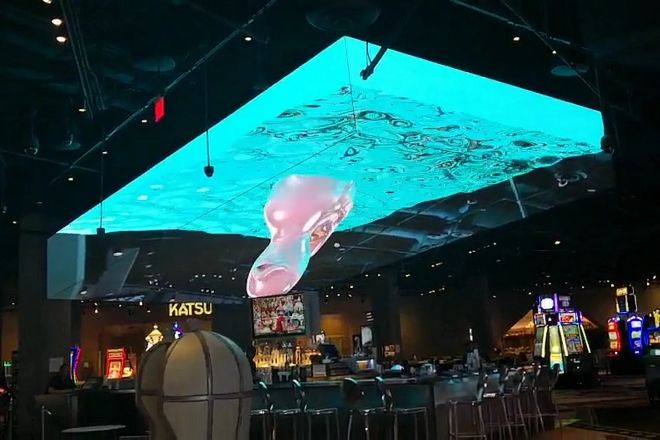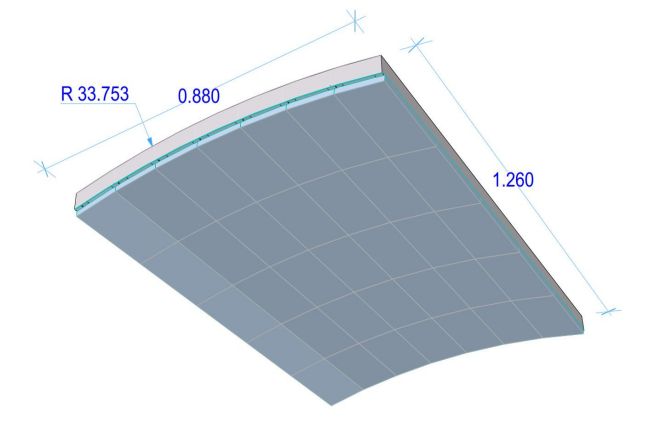介绍

在现代室内设计中,天花板不仅是建筑的结构元素,也是营造独特氛围和美学体验的关键。
但是,安装 LED屏幕 在天花板上安装 LED 屏幕并非易事,它涉及多个技术细节和安全注意事项。在本文中,我们将探讨确保 LED 屏幕在天花板上安全稳定运行所必需的 6 个关键细节。
细节一:选择合适的LED屏型号

1).考虑天花板的承重能力
首先,看看要悬挂 LED 屏幕的天花板是否能承受其重量。这就像在家里悬挂一幅画或一个钟表一样。
你必须确保墙面或天花板能够支撑它,不会倒塌。所以,你必须选择重量适中的LED屏幕,以确保它不会对天花板造成负担。
2). 看看空间有多大
然后,您必须看看有多少空间可以放置这个 LED 屏幕。测量天花板下的空间大小,就像选择合适的衣柜或沙发一样,以确保它不会太大或太小,可以完美地融入您的空间。
3). 考虑 亮度
如果您打算在明亮的房间或户外使用 LED 显示屏,则需要选择亮度足够高的型号,以便每个人都能清楚地看到显示屏上的内容,即使在阳光或强光下也是如此。但如果在较暗的房间中使用,则不需要这么高的亮度;否则可能会很刺眼。
4). 查看 解决
分辨率就像我们手机的像素一样,分辨率越高,画面越清晰。如果希望画面非常细腻逼真,就像看电影一样,那么就选择高分辨率的LED显示屏。但如果只是显示一些简单的文字或图片,低分辨率可能就足够了。
细节二:LED显示屏安装结构安全评估

1). 检查天花板是否能承受
在安装 LED 显示屏之前,您必须首先确保天花板足够坚固,能够稳定地支撑显示屏的重量。这就像如果您想在墙上挂一个很重的相框,您首先会检查墙壁是否能支撑住。
你需要找专业人士看看天花板的结构,用专门的工具测试它的强度。如果天花板不够坚固,你可能需要增加一些支撑,比如钢架,以增加它的承重能力。
2). 寻找专业人士帮助
为了确保一切顺利,你需要找一位专门的结构工程师来帮忙。他们就像建筑行业的医生,可以准确地告诉你天花板是什么样的,并给你最安全的建议如何安装显示屏。
这些工程师会查看天花板的结构,考虑显示屏的重量和尺寸,然后设计一个安全的安装方案。他们还会监督安装过程,确保每一步都按照计划进行,不会出现危险。
3). 避免潜在危险
有了结构工程师的帮助,你可以避免很多潜在的危险。例如,他们可能会告诉你如何安装显示器才能使其最稳定,不会摇晃或掉落。这样,无论刮风下雨,显示器都可以稳稳地挂在天花板上,让每个人都能安心观看。
细节三:LED显示屏精准安装规划
1). 安装前的“3步”
- 措施:
在安装LED显示屏之前,您应该像做工艺品一样测量安装区域有多大以及天花板的高度和宽度。 您还应该测量显示屏本身的尺寸,以确保它正好适合,不会太大或太小。
- 画:
测量完毕后,你就可以开始“画图”了,不过这次你是在纸上还是在电脑上画。你需要设计显示器应该放在哪里,是应该挂在天花板上还是放在架子上,还要设计它的角度和高度,让它看起来最舒服。
- 安排:
设计好之后还需要“排”,即将显示屏的各个小部分排列好,就像拼拼图一样,确保各个小部分紧密衔接,没有缝隙,这样显示的画面才会完整美观。
2). 对齐和校准的小秘密
为了让显示器的画面更加完美,还需要做到两个小秘密:
- 结盟:
就像你排队锻炼一样,展示的每个小部分都应该排列整齐。
如果对齐不好,图片就会出现缝隙或错位,看起来就不美观了。所以我们必须非常小心地调整它们的位置,使它们都排列整齐。
- 校准:
校准就好比调整显示器的色彩和亮度,要确保显示器显示的色彩最真实,亮度最合适,这样观众观看时才会感觉舒适,画面也更加生动逼真。
细节四:LED显示屏电气及接线要求

1). 电源要求
- 电压和电流:
LED显示屏需要电力才能工作,就像您的手机或电视一样。不同的显示器可能需要不同的电量,有些需要较少的电量(例如小型LED灯带),有些则需要更多的电量(例如大型户外广告牌)。
我们必须确保提供给显示器的电力充足,否则它可能会变暗或根本不亮。
- 稳定的 电源供应:
电源要像水一样稳定,不能有波动,电源不稳定的话,显示器会出现闪烁的情况,或者颜色不对的情况。
因此一定要选择质量好的电源,保证其能够稳定地为显示器供电。
2). 电气接线安全
- 选择合适的电线和插头:
就像我们给手机充电需要用到合适的电线和插头一样,LED显示屏也需要合适的电线和插头来连接电源和显示屏的各个部分,这些电线和插头一定要符合安全标准,不能随便使用。
- 按图接线:
显示屏的说明书上会有接线图告诉我们怎么接线,一定要按照这个图来接线,不要乱接,否则可能会出问题。
- 抗干扰:
有时,线材之间会相互干扰,导致显示屏显示不正常,这时就要采用一些方法来减少这种干扰,比如使用专用线材,或者将线材分开。
3).确保电源稳定
- 使用稳压器:
稳压器就像是一个“电源调节器”,它可以保证供给显示屏的电源稳定,不会因为外界电压的变化而变化。
- 定期检查:
我们要定期检查显示屏的电线、供电设备是否有老化、损坏的情况,如果有问题要及时维修或者更换。
- 适应环境:
如果显示屏放置在室外或者环境比较恶劣(比如经常打雷、下雨)的话,我们要采取一些防护措施,保证显示屏的安全运行,比如安装避雷针、使用防水电源等。
细节五:LED显示屏散热与通风注意事项

LED显示屏工作的时候,就像一个努力发光的“小太阳”,但也会很“热”!
这个“热”就是工作时产生的热量,如果这些热量一直积存在显示器里不散去,就像我们夏天穿太多衣服一样,会感觉闷热难受,甚至会生病。
LED显示屏也是一样,热量太大会影响它的工作,使它变暗,颜色不对,甚至会坏掉。
1).那么,如何帮助LED显示屏散热呢?
首先,我们可以在上面安装一些“小风扇”,就像我们房间里的电风扇一样,可以吹走显示器里的热量,让空气流通。这些“小风扇”会不停地转,把热风吹走,让冷风进来。
另外,还要保证显示器周围有足够的空间,不要太拥挤,这样空气才能自由流通,带走热量。
就如同我们在房间里,如果门窗紧闭,空气不流通,就会感觉闷热,因此给显示屏留出“呼吸”的空间很重要。
另外,我们还要定期清洁显示器及其周围区域,因为灰尘和杂物会堵塞散热的小孔,使空气无法流通。就像我们的鼻子被堵住了一样,会感觉呼吸困难。因此,保持清洁也是帮助显示器散热的好方法。
总的来说,我们需要像爱护好朋友一样爱护LED显示屏,保证它能够顺畅地“呼吸”、散热,这样它才能时刻明亮地为我们服务。
细节六:后续保养维修渠道预约

当我们安装一块LED显示屏时,就像是给家里增添了一件新家具,但这件“家具”需要特别的呵护。
为了保证它时刻闪闪发亮、正常运转,我们在安装之初就需要给它留一条“路”,这条“路”就是保养、维修通道。
1).为什么需要这个“路径”?
- 便捷护理:
就像我们需要经常打扫房间一样,LED显示屏也需要定期“洗澡”和“体检”。预留通道让我们可以轻松走到显示屏边上,擦拭灰尘,检查小问题,让显示屏始终保持干净健康。
- 安全第一:
如果显示屏出了问题,我们需要维修。如果没有预留通道,我们可能会站在不安全的地方,或者需要使用不安全的工具来维修,很容易受伤。所以,这条“通道”也是为了我们的安全。
- 长期规划:
随着时间推移,显示屏可能需要一些升级或更换部件。如果我们一开始就预留通道,这些工作就会变得非常简单和快速,同时也节省了未来的成本和时间。
2).那么,如何才能让维护和升级变得便捷呢?
- 区块设计:
我们可以把显示屏分割成很多小块,每个小块都可以单独拆卸,这样如果某个小块出现问题,我们只需要更换那一块,而不需要移动整个显示屏。
- 合理安排岗位:
在安装显示屏的时候,我们要保证周围有足够的空间,以便维护人员可以轻松走过去,而不用挤来挤去。
- 统一标准:
不同品牌、不同型号的显示器,其接口、配件可能都不一样,如果能尽量采用统一的标准,维护、升级会更加方便。
- 智能管理:
现在有很多智能设备可以远程监控显示屏的状态,这样我们就可以提前发现和处理问题,减少现场维护的次数。
- 专业培训:
维护人员需要知道如何正确保养显示屏。因此,我们需要为他们提供专业的培训,让他们知道如何才能让显示屏保持最佳状态。
结论
正确地在天花板上安装LED显示屏,不仅可以提升空间的美学价值,还可以提高信息传递的效率和效果。
通过关注结构安全、精确规划、电气布线、散热通风、维护通道等关键细节,确保LED显示屏的安装既美观又实用。
随着技术的不断进步,LED显示屏的应用将会更加广泛,其安装和使用也会变得更加简单、安全。
最后,如果你想了解更多关于 LED 显示屏的信息, 请与我们联系。
